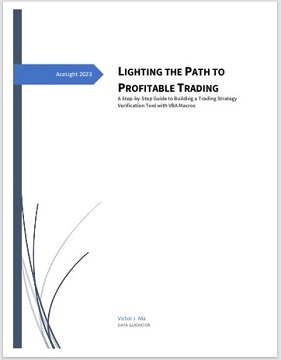The Myth of the Best Stock Trading Strategies:
Why One-Size-Fits-All Doesn't Work in the World of Trading
|
|
Have you heard the one about the "best" stock trading strategy? It's a bit
like the Loch Ness Monster or Bigfoot - everyone talks about it, but no
one's ever seen it. Yes, there are hundreds of trading strategies out there,
but let's face it, finding the "best" one is like finding a needle in a
haystack. And we all know how hard that is, especially if you're not a
farmer.
But in all seriousness, the idea of a "best" trading strategy
is a bit of a myth. Sure, there are strategies that work well for certain
types of stocks and investors, but there's no one-size-fits-all solution.
It's like trying to find the perfect outfit - it might look great on one
person but terrible on another.
Investing in the stock market can be
a daunting task for many individuals. With so many trading strategies
available, it's not surprising that people often wonder whether there are
any "best" stock trading strategies in the world. The truth is, there are
hundreds of trading strategies, but no single strategy can solve every
problem for every investor.
The idea of a "best" trading strategy is
a misnomer. Instead, we can say that certain trading strategies work well
for specific types of stocks, under certain conditions, and for certain
types of investors. For instance, a momentum trading strategy may work well
for volatile stocks, while a value investing strategy may be more suitable
for stable stocks with a steady stream of earnings.
Let's consider a
few examples of trading strategies that work well for specific types of
stocks and investors.
1. Momentum trading strategy: A momentum
trading strategy involves buying stocks that are gaining momentum and
selling those that are losing momentum. This strategy works well for
volatile stocks that experience frequent price fluctuations. For example, a
momentum trader may buy shares of a tech company that just released a new
product, anticipating that the stock price will rise as more investors
become interested in the company's future growth prospects.
2. Value
investing strategy: A value investing strategy involves buying stocks that
are undervalued by the market and selling those that are overvalued. This
strategy works well for stable stocks with a steady stream of earnings. For
instance, a value investor may buy shares of a large pharmaceutical company
that is trading at a discount compared to its earnings and book value,
anticipating that the market will eventually recognize the company's true
value.
3. Day trading strategy: Day trading involves buying and
selling stocks within the same trading day, taking advantage of short-term
price fluctuations. This strategy works well for investors who are
comfortable with high-risk, high-reward scenarios and have the time to
monitor the market closely throughout the day. For example, a day trader may
buy shares of a stock in the morning and sell them later in the day if the
stock price has increased, taking advantage of the short-term gain.
4. Growth investing strategy: A growth investing strategy involves buying
stocks of companies with high growth potential, anticipating that the
company's earnings will continue to grow over time. This strategy works well
for investors who are comfortable with higher risk and are looking for
long-term growth opportunities. For instance, a growth investor may buy
shares of a small tech startup that is showing promising signs of growth,
anticipating that the company will eventually become a major player in its
industry.
In summary, different trading strategies work well for
different types of stocks, market conditions, and investors. It's essential
to perform thorough testing and research before selecting a trading strategy
and to understand the underlying principles of the strategy to make informed
investment decisions.
Here are some tips for seeking a good stock
trading strategy:
1. Research and Educate Yourself: Before diving
into the world of stock trading, it's essential to educate yourself on the
different trading strategies that exist. There are countless books, online
resources, and courses available to help you get started.
2. Define
Your Goals: It's crucial to define your goals before choosing a trading
strategy. Are you looking for a long-term investment or short-term gain?
What is your risk tolerance? By defining your goals, you can narrow down
your options and choose a strategy that aligns with your objectives.
3. Test the Strategy: Back-testing and forward-testing are crucial steps to
testing a trading strategy. Back-testing involves analyzing historical data
to see how the strategy would have performed in the past. Forward-testing
involves using the strategy in real-time with a small amount of capital.
These steps help you determine if the strategy works in practice, not just
in theory.
4. Monitor and Adapt: The stock market is constantly
changing, and trading strategies must adapt to keep up. Regularly monitoring
the performance of your chosen strategy and making adjustments when
necessary can help you stay ahead of the curve.
5. Seek Advice:
Finally, seeking advice from experienced traders or financial advisors can
be a valuable resource when seeking a good stock trading strategy. They can
offer insights into the market and help you make informed decisions.
However, remember to do your own research and make your own decisions.
 The
most important part is the TEST. Without proper testing processes, including
back-testing and forward-testing, even the most famous trading strategies
may not be suitable for all investors. A trading strategy that works well
for one investor may turn out to be a disaster for another. Therefore,
investors need to do their homework before investing their money. The
most important part is the TEST. Without proper testing processes, including
back-testing and forward-testing, even the most famous trading strategies
may not be suitable for all investors. A trading strategy that works well
for one investor may turn out to be a disaster for another. Therefore,
investors need to do their homework before investing their money.
The
testing process involves analyzing historical data to evaluate the
effectiveness of a trading strategy. Back-testing involves analyzing past
data to identify whether a trading strategy would have been profitable.
Forward-testing involves applying the trading strategy to current market
conditions to evaluate its effectiveness.
For more details, click
LIGHTING THE PATH TO PROFITABLE TRADING: A Step-by-Step Guide to Building a Trading Strategy Verification Tool with VBA Macros to get the whole tutorial handbook for free!
And click Free Trial to download strategies testing tools, all for a 30-day Free Trial.
Click on Subscription to order more strategies testing tools to help your stock trading.
Investors need to be aware of the tricks and secrets inside trading
strategies. It's crucial to understand the fundamentals of a trading
strategy and the reasoning behind it before applying it to real-world
investing. Moreover, investors need to consider their risk tolerance,
investment objectives, and time horizon before selecting a trading strategy.
A strategy that works well for a long-term investor may not be suitable for
a short-term trader.
So, if you're looking for the holy grail of
stock trading strategies, you might be searching for a while. But don't
worry, you're not alone. We're all in this together, like a bunch of lost
travelers in a corn maze. And just like in a corn maze, sometimes you take a
wrong turn and end up in a dead end. But hey, at least you got some
exercise, right?
In the end, the key to successful stock trading is
not about finding the "best" strategy, but rather finding the one that works
best for you. So, keep testing, keep experimenting, and don't be afraid to
pivot when needed. And remember, even the most experienced traders make
mistakes sometimes. So, embrace the ups and downs of the stock market and
enjoy the ride - after all, laughter is the best medicine, especially when
it comes to navigating the unpredictable world of trading.
|


|

Free Tutorial
Share
|
|
|
|